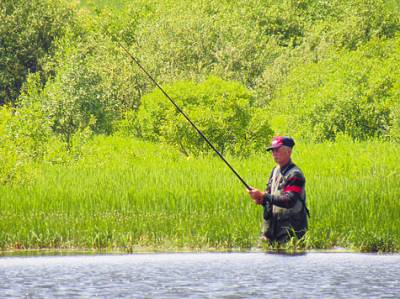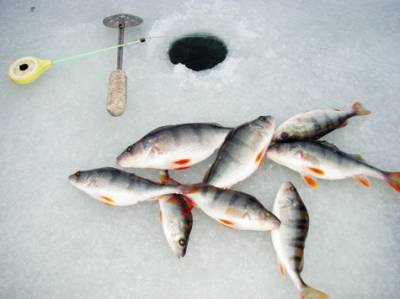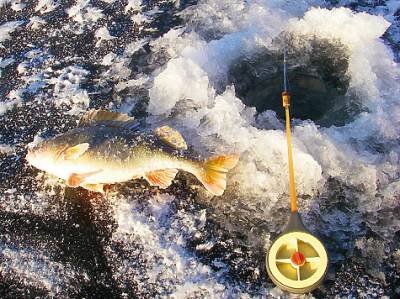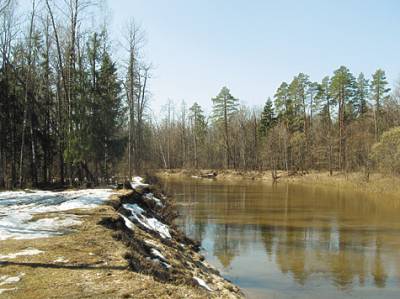
Underwater plants are the most important native forage for fish during the warmer time of the year. Vegetation is a refuge for larvae, worms, snails, crustaceans, fry of the year. At different times of day, in different conditions, different fish visits the place of the reservoir with well-developed vegetation.
Big fish prefer to look for food in the Bush at night, but there are fish such as tench and Rudd, which selects the summer habitat and feeding exclusively among the plants. Rotan during the period of warm water never leaves of riparian vegetation. The most interesting places for catching bream, carp, roach or carp located on the border of aquatic vegetation, particularly if it immediately starts the drop-off in depth, that is, there is a sharp edge. Here and more likely to approach fish to the bait, and the fish are less cautious and active, and technically easier to catch than among plants.
Nibble fish “starts even before the first rays of the rising sun, when it starts the process of photosynthesis in plants. Fishing effectively in very shallow areas with a depth of from 30 to 120 cm, with a greater risk of snags. It is worth noting that if the fish is not to scare, the biting may continue both day and night, which is typical for the beginning of summer. Fishing conditions determine the design of the tackle and bait, and tactics of catching.
To facilitate fishing the majority of fishers are trying to choose a point of catching in the least overgrown part of the reservoir in the place where there are large gaps in the vegetation water. I think that it is wrong. Because the fish is looking for food in the immediate vicinity of the plant, where more and oxygen, and feed.
When choosing a place of fishing I are based on observations in what place and at what time of day the fish are active. This is visually expressed in bursts, the variation of plants in the bubbles rising to the surface of the water. When choosing a place we should not forget that the fish likes, not all aquatic plants. By far the fish likes reeds, Urrutia and water lilies.
As for tackle, here are three options — flight rod, plug and jig. The complexity of using flapping rods is only in the fact that it is often difficult to accurately throw a light and hold the snap point of fishing, especially in a crosswind. The most easy to use mahovym rod in that case, if the bait is large and heavy, for example, a worm or a few kernels of corn. In this case you can use a long float with single point fixing, bait and shepherd boy to put on the bottom to tame the place and patiently wait for a bite.
If the fish prefer falling or moving bait in the form of maggots, caddis or bloodworm, it makes sense to use a plug or a summer jig. These two methods have in common is that the tooling is lowered, not thrown, to the point of fishing.
For the method of catching summer jig as bait is used the lure, and as an independent bait and with the bait or the nozzle on the hook. As indicator of bites used a nod, and often a pointer.
A nod from the watch is characterized in that with the help of mormyshkas nod given game, but the pointer only detects the bite. The advantages of such gear include: delivery accuracy bait at buoys, the possibility of fishing in any water, the ability to play the bait. The disadvantages I’d personally took that opportunity of nod are implemented in full measure only under quite comfortable conditions for fishing. The same can be said about the micro jig.
The plug method not only can effectively catch, and on the border of the grass, but also gives the opportunity to get rid of blemishes by replacing the gear with a nod to float snap-in. Float tackle allows you to lock the lure on the specific aquifer and give the fish time to study it, on the assessment of palatability and cautious and slow absorption.
Very often it is enough to plug with a length of 5-6 meters, but the needed power. The fact is that when fishing in the vicinity of grass you have to equip the rod stiffer shock absorber to force the fish fish. Than plug rod in short, the more we have to think about how to protect when fishing for big fish.
Practice shows that the use of thicker fishing line 0.16 mm makes no sense in any case. Even if you got a really big trophy, for example, carp or tench, thick lines will not help, because three-kilogram Lin will still have time to get a snap of the lilies and cut the hook.
Because fishing occurs in shallow waters, are rarely used snap weighing more than one gram. I in such circumstances, never use floats with a capacity of more than 0.5-0.6 g.
The technique of fishing in a confined space determines the features in the design of the equipment. When the boundary is a “vertical” fishing the most effective two harness snap-in: slow sinking bait to the horizon catching and holding the tooling in one place. Therefore, the design of the tooling as simple as possible.
Above the hook at a distance of 5-10 cm is attached to a very small sinker-shepherd boy, and above it, at a distance of up to half a meter, on the line is the main sinker. I can recommend you to combine the sinker with a shepherd boy. This is especially effective when using large bait. Be careful with the biting, you shepherd boy to write about the hook, and the main sinker to move to the keel of the float.
Because when fishing the plug angler seldom change the place of fishing, it makes sense to use the bait. Here are two important things. First, fishing in the coastal zone cormen edge grass requires very careful choice of the composition of the bait. As practice shows, the most effective bait, consisting of feed ingredients with no added binders, buffers, excipients. It could be the bloodworms, maggot, chopped worms, flakes “Hercules”. To any standard purchase bait, I am skeptical.
The second is the accuracy of feeding. Can lure in the usual way. That is, to toss in a point of catching small balls of groundbait. But you need to throw very accurately. On a hook suspended depth gauge, snap-in, is lowered into the water and lure, trying to get the bait to the float. Focus on the leaves of aquatic vegetation is erroneous, if there is a breaking wave or the wind is blowing from a side. The leaves of the same lilies make “migration” within the meter.
You need to keep in mind and remember that every inaccurately abandoned lump of bait will act as a “antiprigarnoe”, as it would be not to concentrate but to disperse the fish in the area. Worse, if the bait starts to roll deep.
If you feed a “clean” maggots or bloodworms, I recommend you make use of the small plastic Cup that is attached on the tip of a specially designed reserve “pillars” of the plug. In a Cup put a portion of the animal bait plug comes to the working length minus 20-40 cm (snap gradually washed up on the beach) and the Cup is inverted. This is a guaranteed feeding accuracy, quietness and natural fall forage in the water column.
Fishing technique is quite simple. Rigging bait on the hook as slowly as possible lowered vertically on the point of complementary feeding. The lowering speed should be the same as if the bait is in the form of bloodworm, maggots or petal “Hercules” freely falling in the water. It is the most efficient wiring. After the bait reached the bait, you should wait for a pause, the duration of which can be up to two to three minutes. If no bites, it is best to lift or snap-in, and then slowly lowered, or poddelnosti her up on the leash and sharply cut. Such methods are effective when fishing for any peaceful fish.
All the difficulties of fishing from shore on the edge of the vegetation elementary solved, if you use the boat. But big fish feels the boat, so the effective distance fishing may be much more than 20 m.








